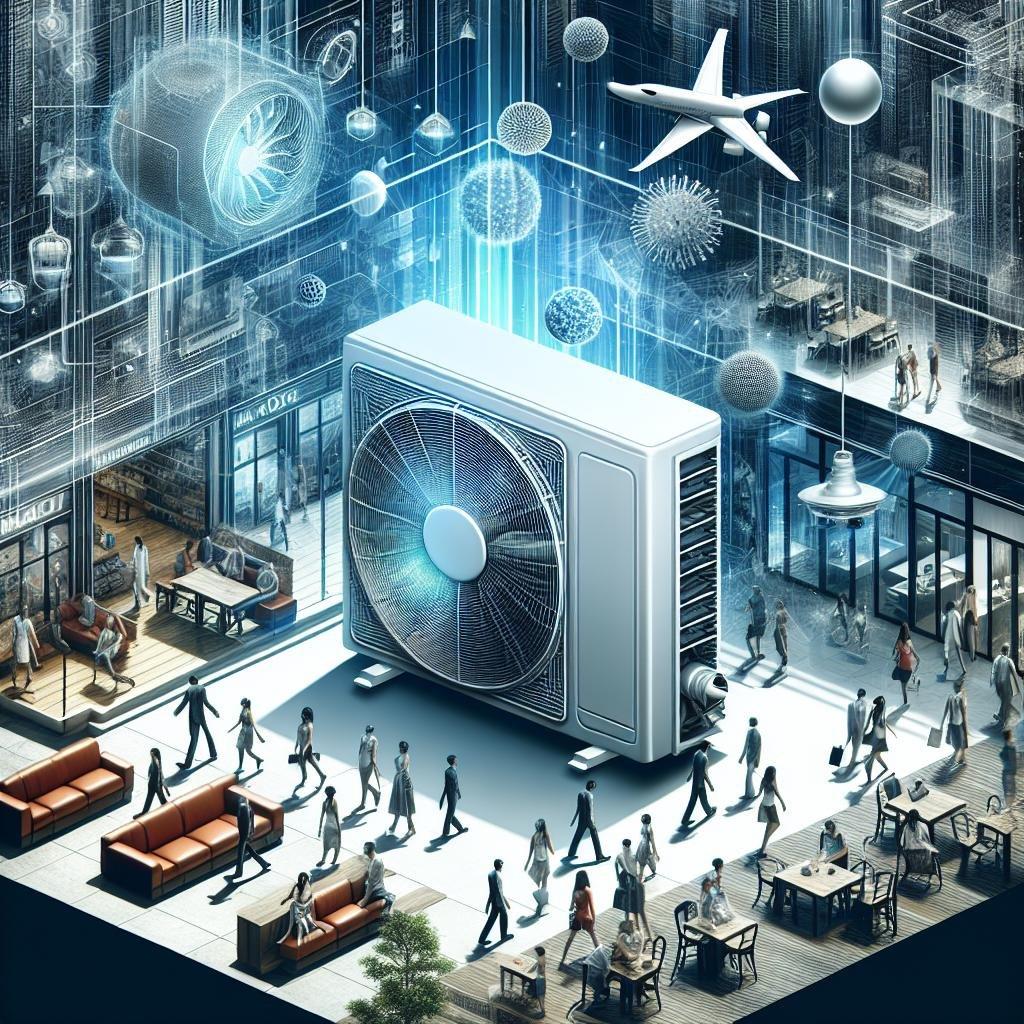In the sweltering embrace of summer, there’s a common thread that unites bustling restaurants, vibrant retail stores, and dynamic office spaces: the need for effective cooling solutions. Among the myriad options available, mini split air conditioning systems have emerged as a favored choice, notably in high-traffic commercial environments. These versatile units boast efficiency and flexibility,offering targeted comfort where it’s needed most.Though, as businesses strive to balance comfort with sustainability, the focus has shifted toward optimizing performance and enhancing energy efficiency. This article delves into the innovative strategies and best practices for mini split AC systems, exploring how these advanced systems can keep large spaces cool while minimizing energy expenditure, all without compromising the experience of patrons and employees alike. Join us as we uncover the secrets to achieving an eco-friendly oasis in the heart of bustling commercial landscapes.
Maximizing Cooling Output through Smart System Design
Creating a cooling system that meets the demands of high-traffic commercial spaces requires an innovative approach to design and integration. By leveraging smart technology, businesses can substantially enhance the efficiency and effectiveness of mini-split air conditioning systems. These systems can be seamlessly integrated with IoT sensors that monitor various environmental factors,adjusting cooling output according to real-time occupancy levels and temperature fluctuations. Consider implementing features such as:
- Adaptive Climate Control: Automatically adjusts settings based on foot traffic and external weather conditions.
- Energy Usage Analytics: Provides insights into power consumption and identifies areas for efficiency improvements.
- Zoning Systems: Allows tailored cooling in different areas, ensuring comfort where it’s needed most.
Moreover, optimizing the layout and installation of mini-split systems can lead to maximum cooling distribution. Utilizing a combination of strategically placed indoor units and proper airflow management can definitely help prevent hotspots and enhance overall comfort levels. It is also beneficial to maintain a regular maintenance schedule to ensure the systems run at peak performance. A few key maintenance practices include:
| Maintenance Task | Frequency |
|---|---|
| Clean or Replace Filters | Monthly |
| Check Refrigerant Levels | annually |
| Inspect and Clean Coils | Bi-Annually |

Enhancing Maintenance Protocols for Sustained Efficiency
To ensure that mini split AC systems operate at peak performance in high-traffic commercial spaces,it is essential to establish rigorous maintenance protocols. These systems, which are often subjected to heavy usage, require regular attention to mitigate the impact of dust and debris that can hinder airflow and efficiency. Implementing a proactive approach can include:
- Regular Filter Checks: Assess and replace or clean filters every month to maintain optimal airflow.
- coil Cleaning: Schedule coil inspections and cleanings at least bi-annually to enhance heat exchange efficiency.
- Drain Line Maintenance: Clear any blockages in the condensate line to prevent water damage and humidity issues.
In addition to routine maintenance, it’s beneficial to integrate advanced monitoring technologies that can track system performance in real time. Utilizing building management systems (BMS) allows for instant feedback on operational efficiency, enabling rapid interventions when anomalies are detected. This technology can also aid in:
- Data Analysis: Collecting past performance data to predict maintenance needs and prevent systems from going offline.
- Energy Consumption Monitoring: Identifying peaks in usage and implementing adjustments to optimize energy efficiency.
- Enhanced Scheduling: allowing for maintenance tasks to be performed during off-peak hours to minimize disruption.

Leveraging Advanced Technology for Real-Time Performance Monitoring
In the quest to enhance the performance and energy efficiency of mini split AC systems, real-time performance monitoring emerges as a game changer. By adopting advanced technology solutions, businesses can tap into a wealth of data that helps them understand exactly how their systems are performing under variable conditions, especially in high-traffic commercial spaces. Key components of this monitoring approach include:
- IoT Sensors: Deploying interconnected sensors throughout the space to gather real-time data on temperature, humidity, and system load.
- Remote Access: Utilizing mobile applications that allow facility managers to oversee system performance from anywhere, ensuring immediate response to any anomalies.
- Data Analytics: Leveraging AI algorithms to process historical and live data to predict maintenance needs and optimize operational settings.
Moreover, the integration of real-time monitoring systems facilitates the creation of thorough performance dashboards that visualize critical metrics. These dashboards serve as an intuitive interface for users to track their AC performance over time. Hear’s a simplified representation of some crucial metrics that can be monitored:
| Metric | Ideal Range | Action Required |
|---|---|---|
| Indoor Temperature | 72°F – 78°F | Adjust settings if outside range |
| Humidity Level | 30% - 50% | Increase dehumidification if high |
| Energy Consumption | Below Benchmark | Investigate spikes in usage |

Implementing User-Centric Controls for Optimal Energy Management
To enhance the performance and energy efficiency of mini split AC systems in busy commercial environments, it’s essential to adopt user-centric controls that empower occupants and managers. By integrating intuitive control interfaces, users can easily adjust settings according to their preferences and the specific needs of the space. Features such as temperature zoning, scheduling, and remote access allow for tailored climate management, mitigating energy waste during non-peak hours. Moreover, incorporating smart technology enables real-time monitoring, ensuring systems run optimally while adapting to occupancy patterns.
Implementing user-centric controls also facilitates better data collection and analysis,leading to informed decisions that continually refine energy use. features like usage analytics and performance feedback can help identify trends, allowing operators to make proactive adjustments. Additionally, offering educational resources or simple how-to guides can empower users to understand their HVAC systems better. The table below outlines key user-centric features and their benefits:
| Feature | Benefit |
|---|---|
| Temperature Zoning | Targeted cooling in high-traffic areas reduces overall energy consumption. |
| Scheduling | Automatically adjusts settings based on peak business hours. |
| Remote Access | Convenient adjustments from mobile devices enhance control over comfort levels. |
| Usage Analytics | Data-driven insights help optimize energy strategies. |
| Performance Feedback | Alerts users to any inefficiencies or maintenance needs. |
Q&A
Q&A: Optimizing Performance and Energy Efficiency of Mini Split AC Systems in High-Traffic Commercial Spaces
Q1: what are mini split AC systems, and why are they ideal for high-traffic commercial spaces?
A1: Mini split AC systems are versatile heating and cooling units that consist of an outdoor compressor and one or more indoor air-handling units. They are ideal for high-traffic commercial spaces, such as retail stores, restaurants, and offices, due to their flexible installation options, energy efficiency, and ability to maintain individual zone control. This allows businesses to adapt temperature settings based on the specific needs of different areas, enhancing comfort for customers and employees alike.
Q2: How can businesses optimize the performance of their mini split AC systems?
A2: To optimize performance, businesses should regularly maintain their mini split AC systems, including cleaning or replacing filters, checking refrigerant levels, and inspecting the outdoor unit for debris or obstructions. Additionally, setting appropriate temperature ranges and utilizing smart thermostats can enhance efficiency. Proper insulation and sealing of doors and windows also help maintain comfort, reducing the load on the AC system.
Q3: What role does energy efficiency play in high-traffic environments?
A3: Energy efficiency is crucial in high-traffic environments where the constant coming and going of people can lead to fluctuating temperature demands. By maximizing energy efficiency, businesses can reduce operational costs related to electricity, which is particularly critically important in spaces with long operating hours. Furthermore, efficient systems can lower the overall carbon footprint, contributing to sustainability goals and enhancing the company’s image.
Q4: Are there specific features to look for in mini split AC systems for commercial use?
A4: Yes,when selecting mini split AC systems for commercial spaces,look for models that offer high seasonal energy efficiency ratios (SEER),variable-speed compressors for better load matching,and the ability to support multiple indoor units for zoned cooling. Features like advanced filtration systems are also beneficial for improving indoor air quality, especially in high-traffic areas where air quality is a concern.
Q5: How does foot traffic affect the temperature management of these systems?
A5: Foot traffic can significantly impact temperature management. In busy commercial spaces,the frequent opening of doors and interaction among people can introduce fluctuating heat loads. Mini split systems that are equipped with smart controls can adapt to these changes by adjusting operation according to real-time occupancy and temperature needs. This responsiveness ensures that spaces remain comfortable without overworking the system or wasting energy.
Q6: What maintenance practices should be prioritized in these environments?
A6: Maintenance practices that should be prioritized include:
- Regular filter Maintenance: Clean or replace filters monthly or as needed, especially during peak operation seasons.
- outdoor Unit Cleaning: Ensure the outdoor unit is free from obstructive debris and is checked bi-annually.
- Thermostat Calibration: Test and calibrate thermostats to ensure they are accurately reflecting room temperatures.
- ductless Installation Checks: For multi-zone systems,inspect connections between the indoor and outdoor units for leaks or issues.
- Seasonal Professional Inspections: Schedule annual inspections from HVAC professionals to catch any latent issues before peak seasons.
Q7: Can integrating energy management systems with mini split ACs improve efficiency?
A7: Absolutely. Integrating energy management systems (EMS) with mini split ACs allows businesses to monitor and control energy consumption in real time. These systems can link up with occupancy sensors and thermostats to reduce cooling when spaces are unoccupied and optimize performance during peak usage times. Such integration not only enhances energy efficiency but can also extend the lifespan of the AC units through more informed usage patterns.
Q8: What are some common misconceptions about mini split AC systems in commercial settings?
A8: Some common misconceptions include:
- They Are Too Noisy: While older models may have surface noise issues,many modern mini splits operate quietly.
- Only For Small Spaces: They can efficiently cool large areas, especially when configured with multiple indoor units.
- High Initial Costs: Though the upfront cost can be higher compared to customary systems, their efficiency and lower running costs frequently enough lead to savings over time.
- Maintenance is Complicated: In reality, with proper guidance, maintenance can be straightforward and manageable.
By addressing these questions, businesses can better understand how to optimize mini split AC systems for energy efficiency and performance in high-traffic commercial spaces, ultimately leading to improved comfort and reduced costs.
To Wrap It Up
In the dynamic landscape of high-traffic commercial environments, the quest for efficiency is an ever-evolving journey. As we’ve explored, mini split AC systems stand at the forefront of this challenge, marrying performance with energy savings in innovative ways. By embracing advanced technology, strategic placement, and regular maintenance, businesses can transform their climate control systems from mere necessities into powerful allies that enhance comfort and reduce operational costs.
As we reflect on the myriad factors impacting these systems—from ambient traffic patterns to seasonal fluctuations—we uncover the critically important role that informed choices play in optimizing both performance and energy efficiency. By prioritizing these aspects, not only can businesses foster a more pleasant and productive atmosphere, but they can also demonstrate a commitment to sustainability and responsible energy use.
The path to efficiency is not merely a destination but a continuous process of adjustment and improvement. As commercial spaces adapt to the ever-changing needs of their occupants,investing in the right mini split AC solutions will undoubtedly yield dividends in both comfort and cost savings. In harnessing these insights,businesses can ensure they not only cool their spaces effectively but do so with an eye towards a more enduring and economically sensible future.
In closing, let us challenge the norms, embrace innovation, and create environments that resonate with efficiency – becuase in the dance between comfort and sustainability, each step counts.

